Psychology Research Report: A Study on Note-Taking and Memory Recall
VerifiedAdded on 2023/06/03
|7
|1392
|209
Report
AI Summary
This psychology research report investigates the effectiveness of different note-taking methods, specifically handwriting versus typing, on memory recall. The study employs the Levels of Processing Theory to understand encoding, storage, and retrieval processes. The report includes an introduction outlining the theory and aims, a method section detailing participant selection and procedures, a results section presenting the findings, and a discussion interpreting the results in the context of previous studies. The study reveals that handwriting tends to result in better memory recall compared to typing, suggesting a deeper encoding process. Limitations such as participant biases and computer literacy are acknowledged, while strengths include the simplicity and ease of administration of the study. The findings emphasize the importance of handwriting for effective learning and memory retention, recommending its preference over typing for learners. Desklib provides access to this and other solved assignments.
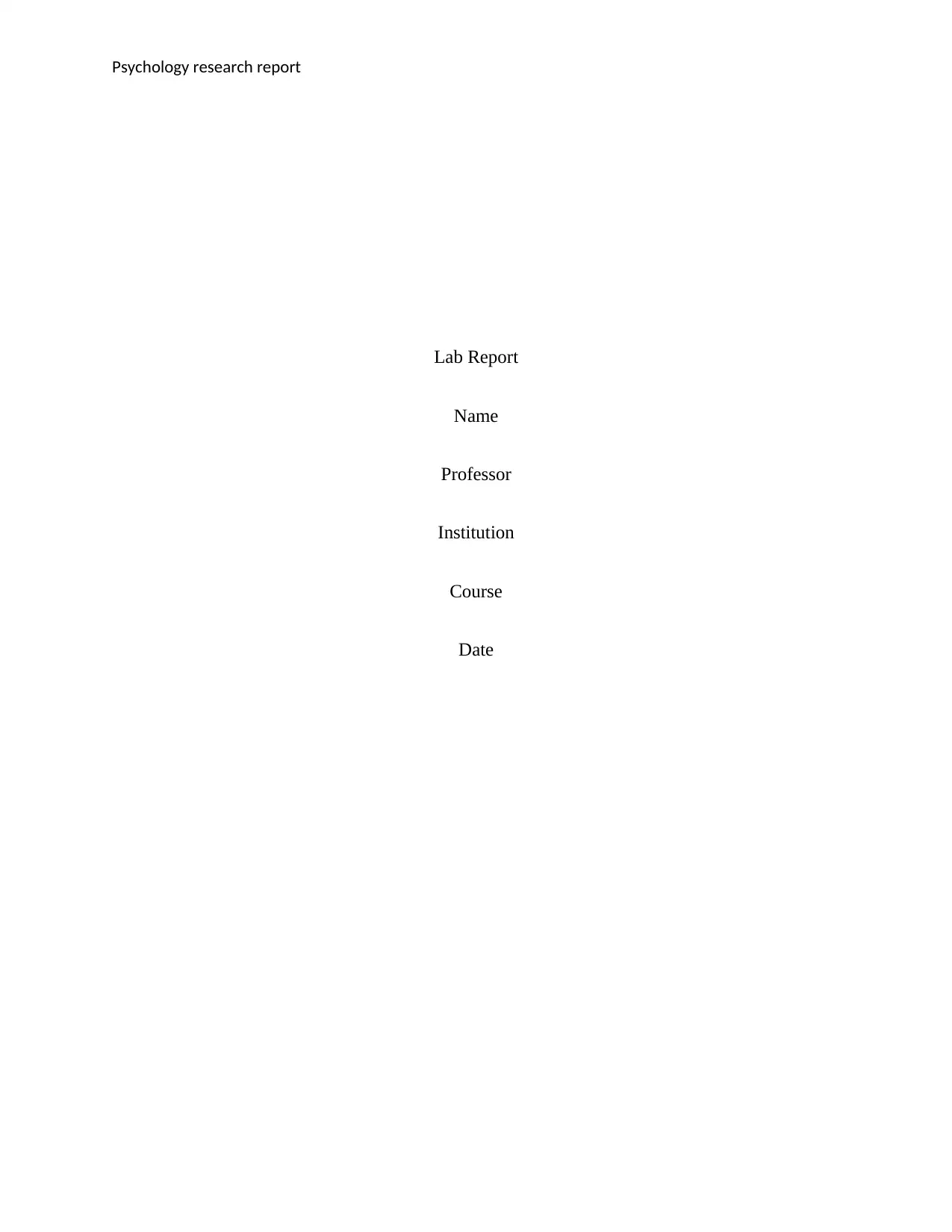
Psychology research report
Lab Report
Name
Professor
Institution
Course
Date
Lab Report
Name
Professor
Institution
Course
Date
Paraphrase This Document
Need a fresh take? Get an instant paraphrase of this document with our AI Paraphraser
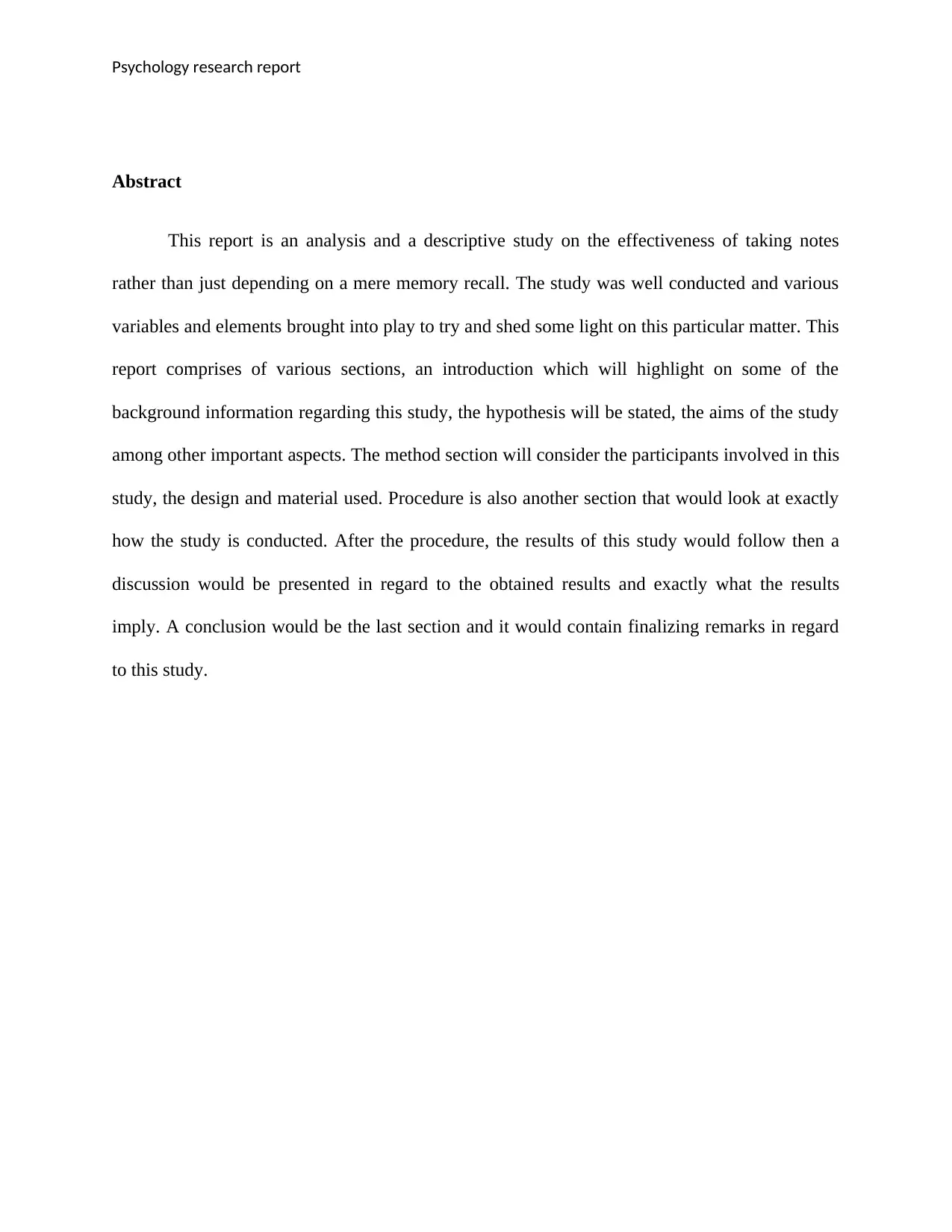
Psychology research report
Abstract
This report is an analysis and a descriptive study on the effectiveness of taking notes
rather than just depending on a mere memory recall. The study was well conducted and various
variables and elements brought into play to try and shed some light on this particular matter. This
report comprises of various sections, an introduction which will highlight on some of the
background information regarding this study, the hypothesis will be stated, the aims of the study
among other important aspects. The method section will consider the participants involved in this
study, the design and material used. Procedure is also another section that would look at exactly
how the study is conducted. After the procedure, the results of this study would follow then a
discussion would be presented in regard to the obtained results and exactly what the results
imply. A conclusion would be the last section and it would contain finalizing remarks in regard
to this study.
Abstract
This report is an analysis and a descriptive study on the effectiveness of taking notes
rather than just depending on a mere memory recall. The study was well conducted and various
variables and elements brought into play to try and shed some light on this particular matter. This
report comprises of various sections, an introduction which will highlight on some of the
background information regarding this study, the hypothesis will be stated, the aims of the study
among other important aspects. The method section will consider the participants involved in this
study, the design and material used. Procedure is also another section that would look at exactly
how the study is conducted. After the procedure, the results of this study would follow then a
discussion would be presented in regard to the obtained results and exactly what the results
imply. A conclusion would be the last section and it would contain finalizing remarks in regard
to this study.
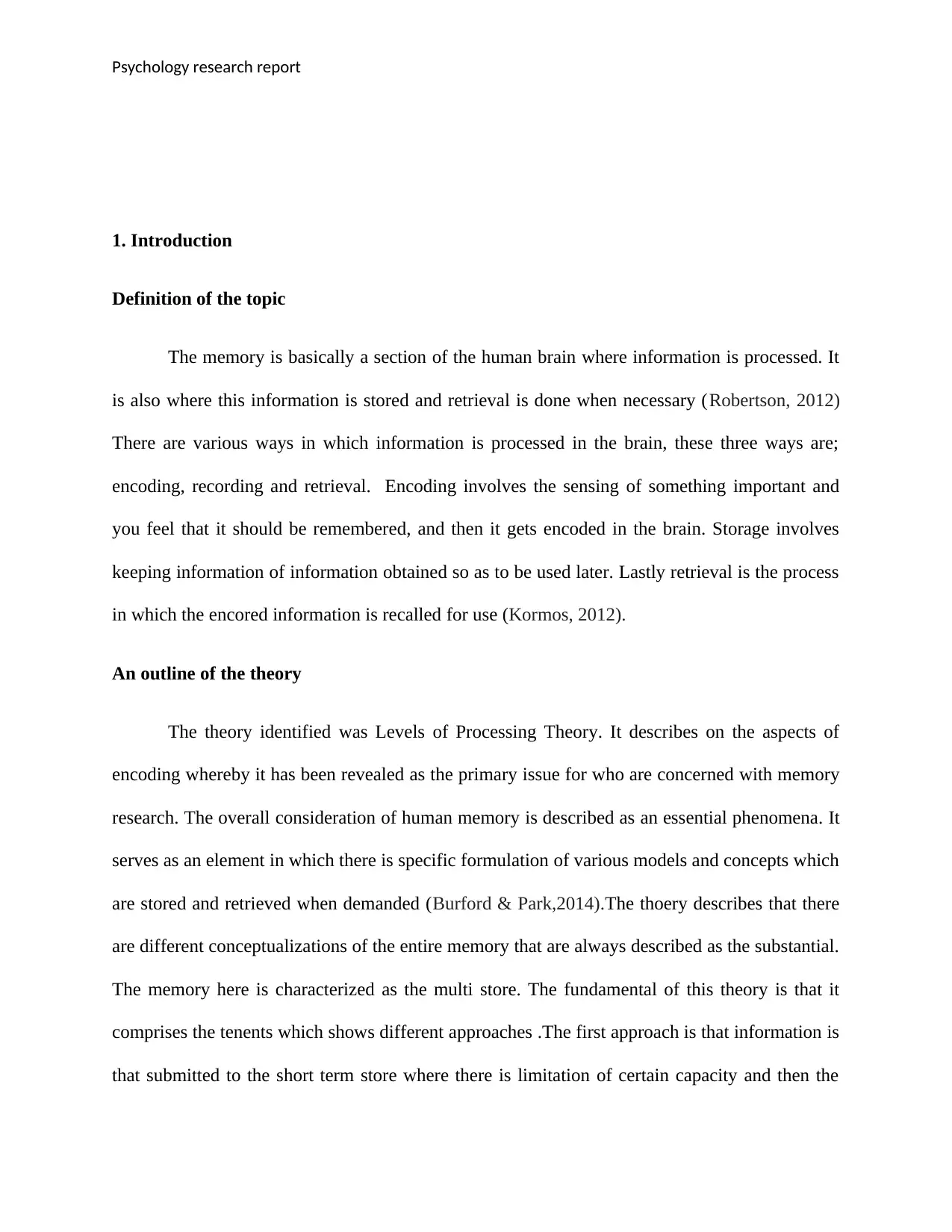
Psychology research report
1. Introduction
Definition of the topic
The memory is basically a section of the human brain where information is processed. It
is also where this information is stored and retrieval is done when necessary (Robertson, 2012)
There are various ways in which information is processed in the brain, these three ways are;
encoding, recording and retrieval. Encoding involves the sensing of something important and
you feel that it should be remembered, and then it gets encoded in the brain. Storage involves
keeping information of information obtained so as to be used later. Lastly retrieval is the process
in which the encored information is recalled for use (Kormos, 2012).
An outline of the theory
The theory identified was Levels of Processing Theory. It describes on the aspects of
encoding whereby it has been revealed as the primary issue for who are concerned with memory
research. The overall consideration of human memory is described as an essential phenomena. It
serves as an element in which there is specific formulation of various models and concepts which
are stored and retrieved when demanded (Burford & Park,2014).The thoery describes that there
are different conceptualizations of the entire memory that are always described as the substantial.
The memory here is characterized as the multi store. The fundamental of this theory is that it
comprises the tenents which shows different approaches .The first approach is that information is
that submitted to the short term store where there is limitation of certain capacity and then the
1. Introduction
Definition of the topic
The memory is basically a section of the human brain where information is processed. It
is also where this information is stored and retrieval is done when necessary (Robertson, 2012)
There are various ways in which information is processed in the brain, these three ways are;
encoding, recording and retrieval. Encoding involves the sensing of something important and
you feel that it should be remembered, and then it gets encoded in the brain. Storage involves
keeping information of information obtained so as to be used later. Lastly retrieval is the process
in which the encored information is recalled for use (Kormos, 2012).
An outline of the theory
The theory identified was Levels of Processing Theory. It describes on the aspects of
encoding whereby it has been revealed as the primary issue for who are concerned with memory
research. The overall consideration of human memory is described as an essential phenomena. It
serves as an element in which there is specific formulation of various models and concepts which
are stored and retrieved when demanded (Burford & Park,2014).The thoery describes that there
are different conceptualizations of the entire memory that are always described as the substantial.
The memory here is characterized as the multi store. The fundamental of this theory is that it
comprises the tenents which shows different approaches .The first approach is that information is
that submitted to the short term store where there is limitation of certain capacity and then the
⊘ This is a preview!⊘
Do you want full access?
Subscribe today to unlock all pages.

Trusted by 1+ million students worldwide
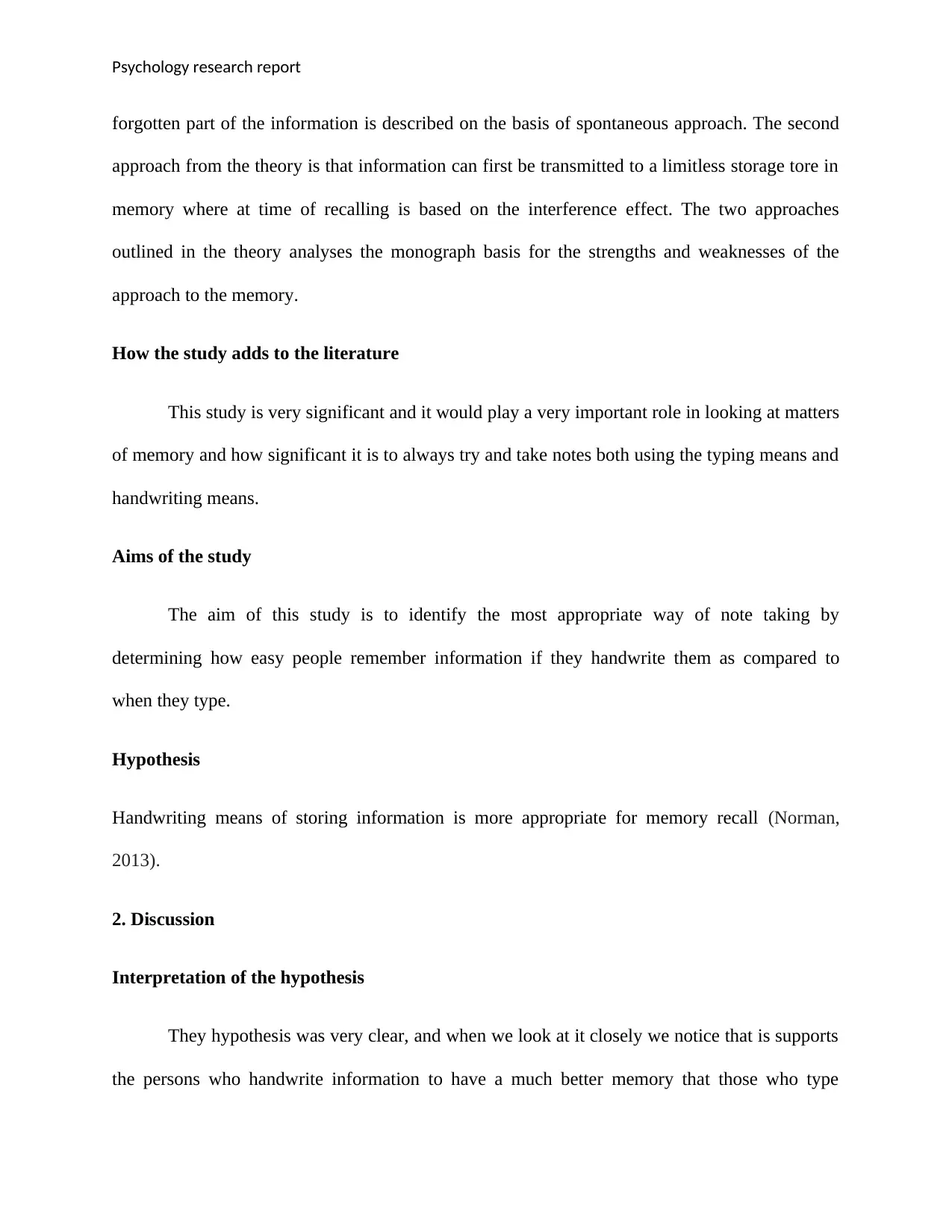
Psychology research report
forgotten part of the information is described on the basis of spontaneous approach. The second
approach from the theory is that information can first be transmitted to a limitless storage tore in
memory where at time of recalling is based on the interference effect. The two approaches
outlined in the theory analyses the monograph basis for the strengths and weaknesses of the
approach to the memory.
How the study adds to the literature
This study is very significant and it would play a very important role in looking at matters
of memory and how significant it is to always try and take notes both using the typing means and
handwriting means.
Aims of the study
The aim of this study is to identify the most appropriate way of note taking by
determining how easy people remember information if they handwrite them as compared to
when they type.
Hypothesis
Handwriting means of storing information is more appropriate for memory recall (Norman,
2013).
2. Discussion
Interpretation of the hypothesis
They hypothesis was very clear, and when we look at it closely we notice that is supports
the persons who handwrite information to have a much better memory that those who type
forgotten part of the information is described on the basis of spontaneous approach. The second
approach from the theory is that information can first be transmitted to a limitless storage tore in
memory where at time of recalling is based on the interference effect. The two approaches
outlined in the theory analyses the monograph basis for the strengths and weaknesses of the
approach to the memory.
How the study adds to the literature
This study is very significant and it would play a very important role in looking at matters
of memory and how significant it is to always try and take notes both using the typing means and
handwriting means.
Aims of the study
The aim of this study is to identify the most appropriate way of note taking by
determining how easy people remember information if they handwrite them as compared to
when they type.
Hypothesis
Handwriting means of storing information is more appropriate for memory recall (Norman,
2013).
2. Discussion
Interpretation of the hypothesis
They hypothesis was very clear, and when we look at it closely we notice that is supports
the persons who handwrite information to have a much better memory that those who type
Paraphrase This Document
Need a fresh take? Get an instant paraphrase of this document with our AI Paraphraser
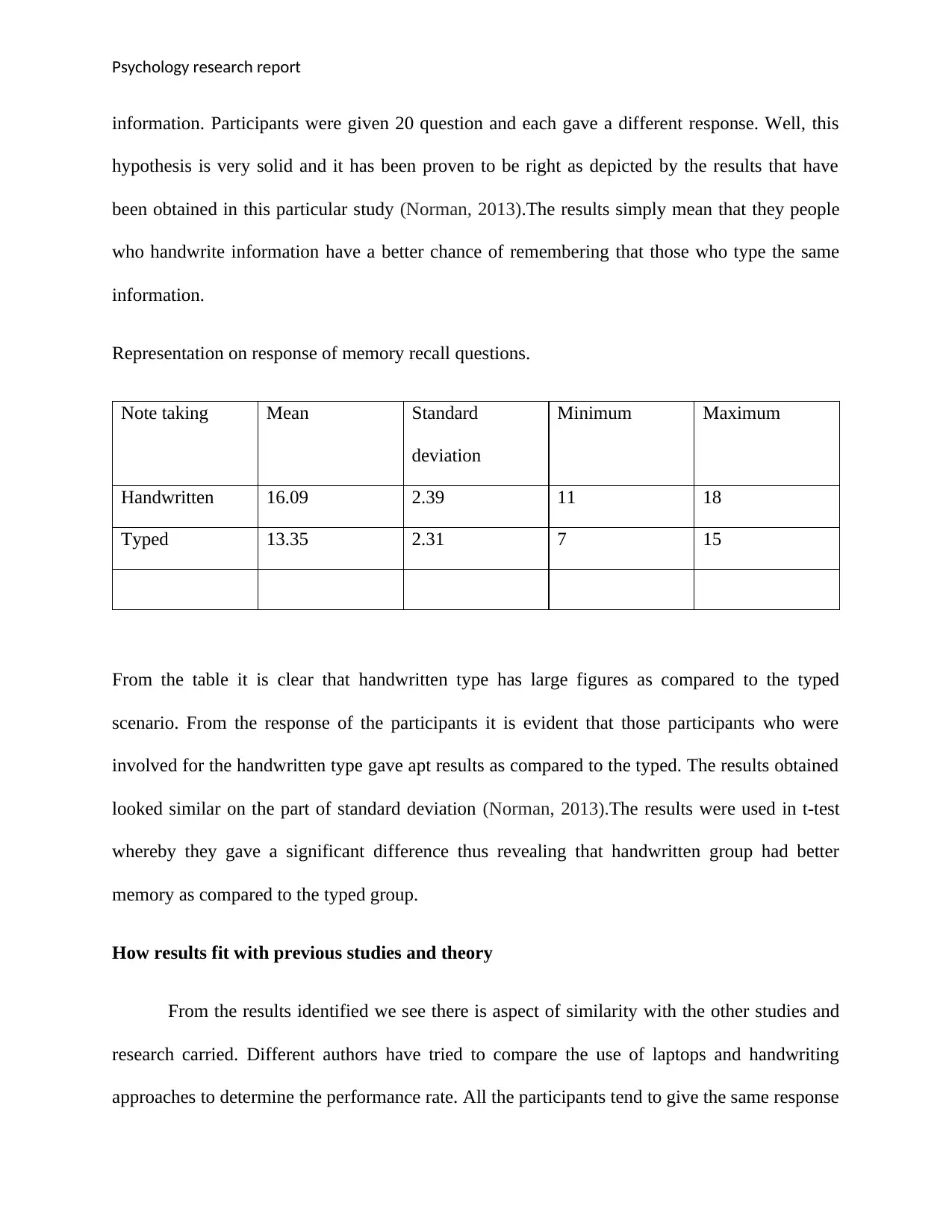
Psychology research report
information. Participants were given 20 question and each gave a different response. Well, this
hypothesis is very solid and it has been proven to be right as depicted by the results that have
been obtained in this particular study (Norman, 2013).The results simply mean that they people
who handwrite information have a better chance of remembering that those who type the same
information.
Representation on response of memory recall questions.
Note taking Mean Standard
deviation
Minimum Maximum
Handwritten 16.09 2.39 11 18
Typed 13.35 2.31 7 15
From the table it is clear that handwritten type has large figures as compared to the typed
scenario. From the response of the participants it is evident that those participants who were
involved for the handwritten type gave apt results as compared to the typed. The results obtained
looked similar on the part of standard deviation (Norman, 2013).The results were used in t-test
whereby they gave a significant difference thus revealing that handwritten group had better
memory as compared to the typed group.
How results fit with previous studies and theory
From the results identified we see there is aspect of similarity with the other studies and
research carried. Different authors have tried to compare the use of laptops and handwriting
approaches to determine the performance rate. All the participants tend to give the same response
information. Participants were given 20 question and each gave a different response. Well, this
hypothesis is very solid and it has been proven to be right as depicted by the results that have
been obtained in this particular study (Norman, 2013).The results simply mean that they people
who handwrite information have a better chance of remembering that those who type the same
information.
Representation on response of memory recall questions.
Note taking Mean Standard
deviation
Minimum Maximum
Handwritten 16.09 2.39 11 18
Typed 13.35 2.31 7 15
From the table it is clear that handwritten type has large figures as compared to the typed
scenario. From the response of the participants it is evident that those participants who were
involved for the handwritten type gave apt results as compared to the typed. The results obtained
looked similar on the part of standard deviation (Norman, 2013).The results were used in t-test
whereby they gave a significant difference thus revealing that handwritten group had better
memory as compared to the typed group.
How results fit with previous studies and theory
From the results identified we see there is aspect of similarity with the other studies and
research carried. Different authors have tried to compare the use of laptops and handwriting
approaches to determine the performance rate. All the participants tend to give the same response
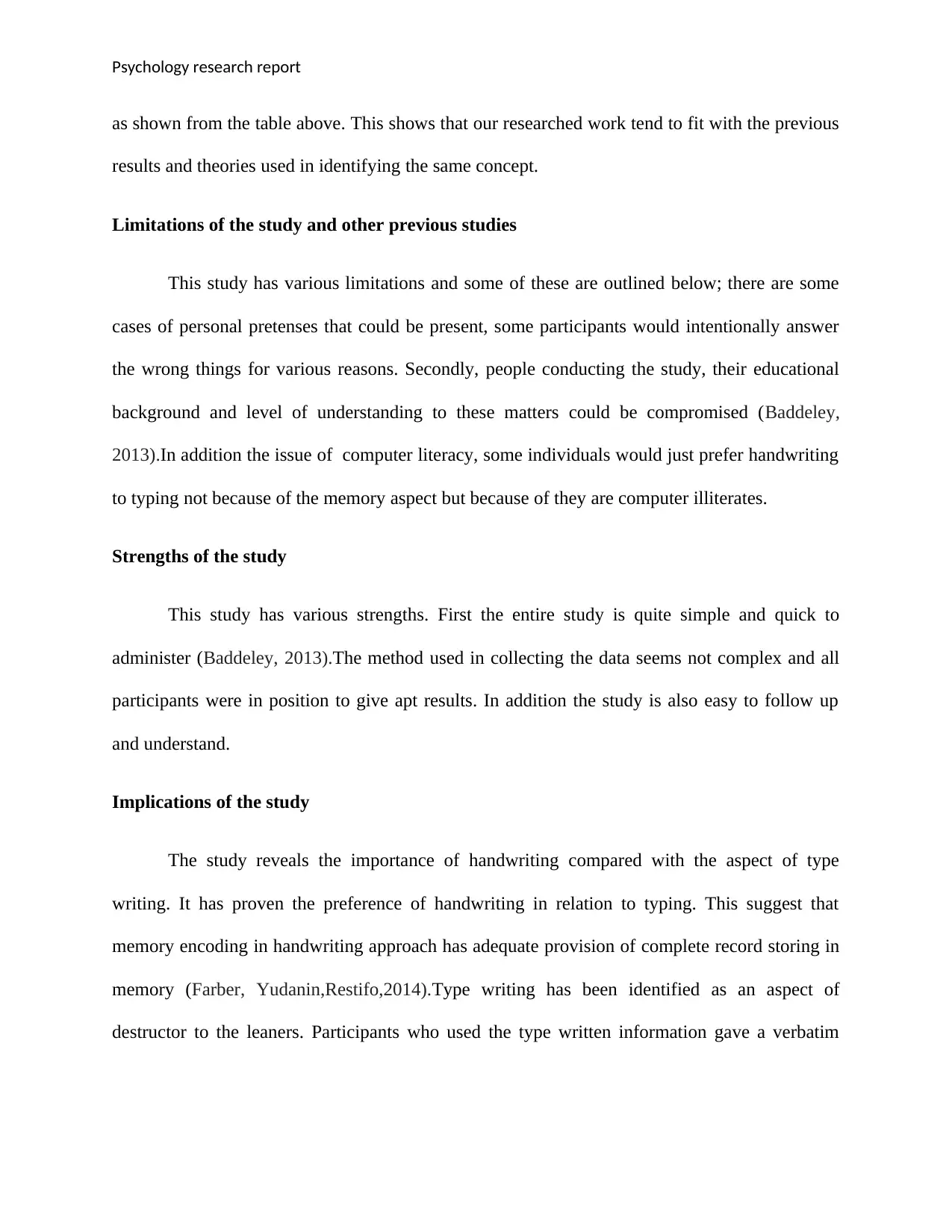
Psychology research report
as shown from the table above. This shows that our researched work tend to fit with the previous
results and theories used in identifying the same concept.
Limitations of the study and other previous studies
This study has various limitations and some of these are outlined below; there are some
cases of personal pretenses that could be present, some participants would intentionally answer
the wrong things for various reasons. Secondly, people conducting the study, their educational
background and level of understanding to these matters could be compromised (Baddeley,
2013).In addition the issue of computer literacy, some individuals would just prefer handwriting
to typing not because of the memory aspect but because of they are computer illiterates.
Strengths of the study
This study has various strengths. First the entire study is quite simple and quick to
administer (Baddeley, 2013).The method used in collecting the data seems not complex and all
participants were in position to give apt results. In addition the study is also easy to follow up
and understand.
Implications of the study
The study reveals the importance of handwriting compared with the aspect of type
writing. It has proven the preference of handwriting in relation to typing. This suggest that
memory encoding in handwriting approach has adequate provision of complete record storing in
memory (Farber, Yudanin,Restifo,2014).Type writing has been identified as an aspect of
destructor to the leaners. Participants who used the type written information gave a verbatim
as shown from the table above. This shows that our researched work tend to fit with the previous
results and theories used in identifying the same concept.
Limitations of the study and other previous studies
This study has various limitations and some of these are outlined below; there are some
cases of personal pretenses that could be present, some participants would intentionally answer
the wrong things for various reasons. Secondly, people conducting the study, their educational
background and level of understanding to these matters could be compromised (Baddeley,
2013).In addition the issue of computer literacy, some individuals would just prefer handwriting
to typing not because of the memory aspect but because of they are computer illiterates.
Strengths of the study
This study has various strengths. First the entire study is quite simple and quick to
administer (Baddeley, 2013).The method used in collecting the data seems not complex and all
participants were in position to give apt results. In addition the study is also easy to follow up
and understand.
Implications of the study
The study reveals the importance of handwriting compared with the aspect of type
writing. It has proven the preference of handwriting in relation to typing. This suggest that
memory encoding in handwriting approach has adequate provision of complete record storing in
memory (Farber, Yudanin,Restifo,2014).Type writing has been identified as an aspect of
destructor to the leaners. Participants who used the type written information gave a verbatim
⊘ This is a preview!⊘
Do you want full access?
Subscribe today to unlock all pages.

Trusted by 1+ million students worldwide
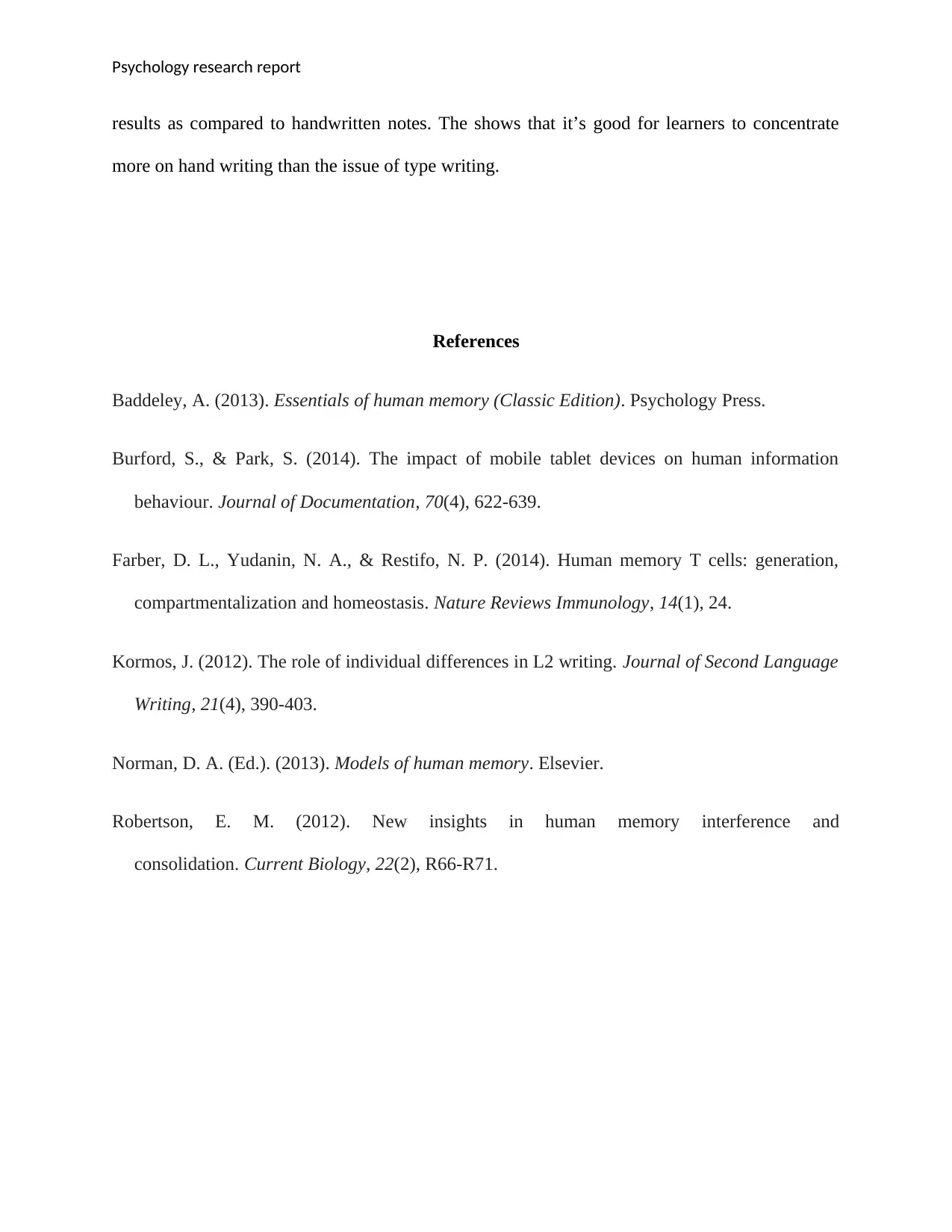
Psychology research report
results as compared to handwritten notes. The shows that it’s good for learners to concentrate
more on hand writing than the issue of type writing.
References
Baddeley, A. (2013). Essentials of human memory (Classic Edition). Psychology Press.
Burford, S., & Park, S. (2014). The impact of mobile tablet devices on human information
behaviour. Journal of Documentation, 70(4), 622-639.
Farber, D. L., Yudanin, N. A., & Restifo, N. P. (2014). Human memory T cells: generation,
compartmentalization and homeostasis. Nature Reviews Immunology, 14(1), 24.
Kormos, J. (2012). The role of individual differences in L2 writing. Journal of Second Language
Writing, 21(4), 390-403.
Norman, D. A. (Ed.). (2013). Models of human memory. Elsevier.
Robertson, E. M. (2012). New insights in human memory interference and
consolidation. Current Biology, 22(2), R66-R71.
results as compared to handwritten notes. The shows that it’s good for learners to concentrate
more on hand writing than the issue of type writing.
References
Baddeley, A. (2013). Essentials of human memory (Classic Edition). Psychology Press.
Burford, S., & Park, S. (2014). The impact of mobile tablet devices on human information
behaviour. Journal of Documentation, 70(4), 622-639.
Farber, D. L., Yudanin, N. A., & Restifo, N. P. (2014). Human memory T cells: generation,
compartmentalization and homeostasis. Nature Reviews Immunology, 14(1), 24.
Kormos, J. (2012). The role of individual differences in L2 writing. Journal of Second Language
Writing, 21(4), 390-403.
Norman, D. A. (Ed.). (2013). Models of human memory. Elsevier.
Robertson, E. M. (2012). New insights in human memory interference and
consolidation. Current Biology, 22(2), R66-R71.
1 out of 7
Related Documents
Your All-in-One AI-Powered Toolkit for Academic Success.
+13062052269
info@desklib.com
Available 24*7 on WhatsApp / Email
![[object Object]](/_next/static/media/star-bottom.7253800d.svg)
Unlock your academic potential
Copyright © 2020–2025 A2Z Services. All Rights Reserved. Developed and managed by ZUCOL.





